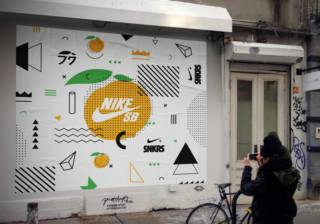For the average sneaker enthusiast, purchasing a coveted pair of kicks can be as monumental a task as stitching the shoes from scratch.
Marketers are making this process easier—and taking advantage of a $55 billion global industry—by using mobile augmented reality apps, influencer-inspired lines and other emerging tech to reach consumers who thrive on sneaker culture.
Take Nike. The brand is using its new SNKRS app to digitize the way the Phil Knight-founded company vends shoes with GPS and AR to complement the hype behind its releases.
“The Nike SNKRS app is an important part of our digital strategy,” Jenna Golden, Nike’s director of North American communications, told AListDaily. “It’s something that we’ve invested in over the last year. Since the start of 2017, we’ve really built out those digital experiences.”
Nike has developed its digital shock-drop approach with geo-located experiences in Berlin, Chicago, New York and Los Angeles through SNKRS Stash, an app feature that allows users to unlock access to hidden “stash spots” in their hometowns.
Since the experiences it’s cultivating require physical interaction with buyers, the move further positions the brand to combat bots and auto-buying tools that make purchasing limited-edition shoes seemingly impossible.
During ComplexCon, Nike also reached consumers who were not able to make it to the show in LA by opening up its camera experience and allowing fans to purchase one of the five shoes that were dropped at the show. A similar gamified strategy was used by incorporating AR for the drop of the Nike SB Dunk High Pro “Momofuku.” Consumers who scanned an image of David Chang’s Fuku East Village menu were given the opportunity to purchase the shoe.
Nike is a pioneer on the mobile AR front. SNKRS AR is looking to scale and fend off competitors like Adidas, which has grasped a sizable market share of late in both the United States and Europe.
In September, the striped brand surged past the Nike-owned Jordan Brand as the second most popular shoe brand in the US after Nike.
Since mobile is involved with nearly every moment of the purchase journey, consumers with a brand’s app on their phone are more likely to buy from that manufacturer, said Matt Powell, senior industry advisor for NPD Group.
Although mobile apps are a critical part of the marketing gameplan, Powell does not envision AR to have much of a role in the future, saying that it’s “more like a parlor trick—cool once, and after that, not so much.”
“Gamification is growing in popularity with brands, but again, these will have little impact on the commercial business,” said Powell, adding that he thinks there also is fatigue in the market over limited releases.
“I don’t see sneakerheads as very important to brands,” he said. “When [Nike] Tanjun is a top-selling shoe, it illustrates the limits of the sneakerhead community.”
Allison Giorgio, Puma’s vice president of marketing, countered that the sneaker culture is at an all-time high, and that it’s a great time to be a brand in the space.
“The sneaker aficionado space right now is interesting and exciting,” said Giorgio, who has used celebrities like Rihanna as creative directors to revive its brand. “We’re trying to figure out how do we move at the speed of culture that signals trends, innovate faster and release products quicker. Our mission is to be the fastest sport’s brand in the world, and we take that to heart from a development and marketing side.”
Although exclusive sneaker lines have primarily been reserved for star athletes and Hollywood literati, that model is now somewhat also shifting to influencers who sport an entrepreneurial zeal instead of a stellar jump shot.

K-Swiss is rebranding its popular ‘90s brand with an eye toward targeting an audience of hustlers and young entrepreneurs with the campaign “Generation K” and their first signature sneaker shoe line for businessman Gary Vaynerchuk.
But is there consumer demand for such shoes?
“It seems there is another one every 10 seconds,” said Powell. “The people who are vying to buy them are for the most part ‘flippers’ rather than collectors. I think brands will try to leverage brand loyalty but because the pairs are limited, it will have little impact outside of the echo chamber.”
Patrick Buchanan, global marketing director at K-Swiss, told AListDaily that they’re tapping into the millennial mindshare and Vaynerchuk’s built-in fan base to release shoes in stores, online and through drops on Vaynerchuk’s personal social channels.
“Entrepreneurs are the new heroes, and we fully support that,” Buchanan said. “The sneaker culture is a huge imprint on popular culture.”
The brand is heralding the entrepreneurial push of “Generation K” by partnering with @f–kjerry’s Elliot Tebele, streetwear designer Anwar Carrots, social media and marketing strategist Karen Civil and Coco & Breezy founders Corianna and Brianna Dotson.
K-Swiss aims to inspire the “flippers,” who are the primary source behind the $1 billion sneaker resale industry.
Buchanan has been with K-Swiss for a little over a year and joined the brand to execute the new vision. The brand signed a deal last year with Vaynerchuk in Q2, and by Q4, the GaryVee 001 and GaryVee 002 had already hit store shelves. Their speed in production was also an imprint of the changing times.
“It takes almost two years to make a shoe. The conversations we are having internally is ‘how can we do things quicker,’” said Buchanan. “The biggest thing in marketing that is shifting for us is just trying to be faster and more responsive.”
“The biggest thing in marketing that is shifting for us is just trying to be faster and more responsive.” —Patrick Buchanan, global marketing director at K-Swiss
In the past, the brand would have culled marketing materials for the product campaigns as early as a year ahead. Now in order to be more relevant to consumers, Buchanan and his team are preparing marketing materials much closer to launch dates.
“That’s just one example of how we’re trying to work much faster and efficient,” said Buchanan. “When you work for big companies, it’s sometimes hard to turn the ship. You have to be willing to change if it doesn’t make sense.”
Buchanan said the beauty of being a shoe marketer today is that you have to keep your finger on the pulse and embrace industry shifts with new marketing strategies, which is why he’s also shaking up his content marketing mix with the podcast series “CEOs Wear Sneakers.”
“Trends are changing every day, as well as the way people are being touched,” he said. “We’re seeing a shift from retail to online. For me, it’s always trying to be open and listen to what’s happening. I have to be a responsive marketer and move as the trends and times do.”


